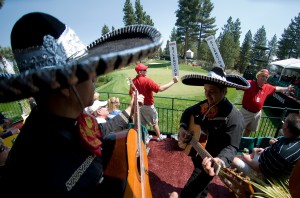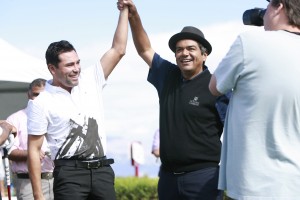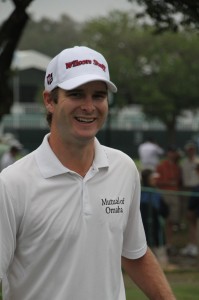Eagle Katsina. Wolf Katsina. Deer Katsina. I want it. Wait a minute. Joe’s third in line. What the heck is that fourth one, Hairless Chihuahua Katsina?
So I did it. I reached over and put a bear-lock on my buddy Joe in the guise of another congratulatory hug for a job done well, and then I casually spun him back to where I was seconds before. I’m not proud of the act, but my wife and I collect Native American art, deer is absent and who wants pug-ugly?
Heard Museum? Scottsdale Celebrity-Am.
This is the flip side of professional golf, one of the hundreds of such events that play across the calendars of the various tours. Teamed with then-Arizona Diamondbacks pitcher Dan Haren, my pals and I nail down a high podium finish, and as the Celeb is one of three such hack tourneys that are part of the FBR oops now Waste Management Phoenix Open and the guys who produce this most popular tour event call themselves Thunderbirds, Hopis should make the trophies.
Hardware is cool and the Ping irons we garner four our second-place finish are over the top. But it’s not about swag. Truth be told, the pro-am is about fun. It’s about business. It’s about charity. How nicely ironic that a whole bunch of weekend warriors fuel the part of golf that’s not about the player who gets the big check come Sunday afternoon, rather who receives the many checks the other 364.
The PGA Tour has generated an astounding $1.5 billion dollars over the years for charities. In 2009 alone, the three series under the tour’s banner—the regular, Champions and Nationwide tours—donated $108 million. Figures for the LPGA Tour are a bit murkier, as tour official Jane Geddes says no running tally has been kept dating back to its inception 60 years ago. However, $200 million in total contributions since 1981 is a figure bandied about by some of the tour’s events. For admission badges, beer sales, chalets greenside, network contracts; at the core is the pro-am.
“It’s all about the pro-am, particularly on the LPGA Tour” says Rob Neal, a former tour official and now executive director of Tournament Golf Foundation, Inc., which puts on Portland’s LPGA event, the Safeway Classic. “In our revenue model, almost everything is somehow connected to the pro-am. The pro-am is probably the most important aspect of the tournament to our title sponsor, Safeway.”
Asked to assess a world without pro-ams, Neal is hesitant: “I don’t know that I want to consider that. We would have to find a completely new way to find money for charity. It would be staggering how the impact would be on local charities.”
It’s win-win-win with pro-ams. There’s the simple math of 200 or 400 or 600 or however many available slots multiplied by the $1,500 or $8,000 or $25,000 tab for each. To some degree pro-ams drive ticket sales and viewership, notably in the celeb-heavy events on the men’s tour. What pro-ams really do is ink the deals with the title, hosting and other sponsors who bankroll tournaments. As Neal says, “In this era it is essential to have a title sponsor. With very few exceptions the pro-am is the very first thing on the mind of that title sponsor.”
Why? To entertain, woo clients and scratch the itch of playing alongside someone who really excels at his or her craft.
“Pro-ams are extremely important for the relationships between the PGA Tour and our sponsors,” says player Kevin Streelman. “It is a direct relationship where we can spend an immense amount of time with executives, customers and people who love golf as we do. That’s the beauty of our sport; we can play up close with amateurs. It makes for a unique situation and hopefully a fun situation for both parties.”
“One of the great things about golf as it relates to business or it relates to the fan is that we can go out and play golf together,” echoes LPGA star Natalie Gulbis. “What other sport can you do that in? We can spend time with our sponsors or spend time with individuals who really want to play with the pros, and we can play together and enjoy it together.”
We don’t want this guy, period.
So says a pal who has been around the block a few times when it comes to pro-ams and tour personalities. We draw Streelman for the Reno-Tahoe Open Pro-Am; actually, we pick him at the pairing party, the night-before soiree of grub and grog, entertainment and a bit of lotto where amateurs hope to avoid the tour notoriously cranky tour pros, to put it mildly, and trust me, they are out there. Streelman’s one of the good guys, and thankfully he’s still in the pool when our number is drawn about halfway through the draft.
Alas, poor Streelman doesn’t know what’s waiting for him as he shows up the next morn to be greeted by The Three Hackertons and a guy who hits his first drive like Happy Gilmore, with none of the success. Pro stripes his drive, knocks a wedge on the green and just misses birdie. I stripe my drive, knock a wedge on the green and putt as you’d expect, thereby squandering a hole where I get a pop. And so begins another typical day in my golf life, except that Streelman isn’t one of my back-at-home “partners” who’ve not evolved much past the rabid cur stage, so he comes over, gives me a bop in the arm, smiles, and says, “We’re a team, we’ll all miss some shots today.” Then he laughs; the par-for-net-birdie putt was from all of 14.7 inches, though I put it at 16.6, easily.
Seventeen holes later we hit 14 under, everyone contributes at least a couple red numbers and we earn a piece of Waterford etched with “3rd Place” and the tourney’s Sierra-in-silhouette logo. Streelman’s day consists of charting yardages and tomorrow’s pin locations—his job. He’s also tendering advice when requested, getting a needed “3” on a par 4 when two of his obviously am-side cohorts have gone yard and two have reached the fringe with driver only to chili-dip and gouge their ways to “other” numbers, telling jokes and generally making four strangers feel like old pals—also his job, or at least as he knows it.
“It’s about friendships,” he says later when I ask him why he has such a positive attitude toward something many of his peers embrace as warmly as USC would another matchup with the Ducks. “It’s about people we meet and keep up with, be it everyone from Jessica Simpson to you guys. People we keep in touch with, stay friends with. And with the longevity that goes with golf these relationships continue for a long time.”
Walking the first round of the tournament proper I cross paths with Streelman near the 9th green. This is work time for him, with a half-mil on the line for the victor. Prior to chipping he comes over, shakes my hand, inquires about our pro-am finish and again says how much he enjoyed the round. He says he’s having a so-so day, yet he has time to sidle over for a chat? This guy is good.
When most think “pro-am,” they likely picture three or four chops doing the Wednesday walk with Paul Casey or Dustin Johnson, playing a better-ball for team glory, even if pros and Joes step up to different tees. And such is the case at the Reno-Tahoe Open. But that’s not the only show in professional golf.
“The PGA Tour guys play their own ball, from a different tee. We’re actually a team from the start,” says Gulbis. “I played in the pro-am at the Justin Timberlake event, with Nick Watney. We had a great time but it’s a practice round for them. In our events you don’t remember how you did individually; you remember how your team did. If some guy is not performing off the tee he can make the birdie putt, so you are doing everything, celebrating together, as a team.”
Streelman wants to see more diversity in PGA Tour pro-ams: “I don’t know why we don’t play a scramble, to be honest. This certainly could move pace of play along and because all are playing from the same spot it would give tour players and caddies more time to talk with the amateurs and interact.”
How to pick? Should you go for an LPGA event with its potentially less stressful scramble format, vibrant personalities and pint-sized women who can kick your rump? The Frys.com Open has an event that pairs an amateur couple with a tour pro and his wife or girlfriend. Vegas’ Justin Timberlake Shriners Hospitals for Children Open is thick with celebrities. Pebble Beach is justly famous for including amateurs in the actual competition; don’t count on getting an invitation even if you are the CFO with an urge to spend.
Ironically, my recent experiences took me to both ends of the spectrum on the PGA Tour.
The RTO, as locals call it, is like the little engine that could, a PGA Tour event set in a stunning setting and a making a niche in a tough position on the calendar playing opposite both the Open Championship (British Open to the ungrateful colonists) and the bless-Barkley-for-still-trying American Century Celebrity Golf Championship at nearby Lake Tahoe. Phoenix—Scottsdale actually—hosts the largest, most well-attended event in all of golf, a Bacchanal of Birdies that organizers call “the Greatest Show on Grass,” where 500,000 people come through the turnstiles and one hole, the 16th, might as well be a WWF site. One’s been around for 12 years, the other since 1932. One distributes proceeds by Cessna, the other by Airbus.

The RTO's Fiesta Loco brings a tiny bit of the Phoenix Open's 16th hole bacchanal to the little tournament that could.
A gulf? Not at all, just a matter of degrees. As sporting events I love them both. The RTO is young, yet is exactly the type of casual, personable, hands-on event the PGA Tour needs as it races headlong toward globalization and farther from the small-town roots that sustained it through most of its existence. The nearly octogenarian Phoenix event runs age-defying frisky and wild, a cross between New Year’s in Vegas and SportsCenter on steroids.
And the bottom line for both is people who love the game, on both sides of the ropes, using it as a vehicle to raise money and have fun.
Back at the Celebrity-Am it’s obvious which guys are on which side of the hyphen. Dan Haren’s definitely the name guy, and he’s definitely an athlete. Standing in at 6’ 5”, with the enviable fluid explosiveness those of his craft possess, the whip-like torso and arms atop two pistons where the rest of us have legs, the boy can go long. No warning-track power here, this is long as in reaching two drivable fours with a fairway metal. And like a good number of the rest of us he can go wrong with his long, being big on love for the game and not quite as enamored of the whole grind-on-the-range-and-practice-green thing.
“I think a lot of golf is dealing with frustration,” says the three-time All-Star possessed of the syrupy putting stroke to be expected of a guy who can hurl a ball 90 mph-plus and make it dance. “Not being the greatest golfer I need to think that last bad shot isn’t my last shot. It’s like pitching. If you give up two or three runs in the first inning you need to step up and try to get it back together, and not give up another run for five or six innings.”
It’s a perfect attitude. Certainly for golf and it would seem baseball.
Active while in Phoenix with the Miracle League of Arizona, which helps out special needs kids, when the head of his ballclub asked if he’d care to participate, Haren jumped at the chance to play in his first-ever tour-affiliated golf event and trade high-fives and the requisite needles with his newfound buds. “I am very lucky playing a game for a living,” he reflects. “It is important that I give back to the community.”
Give back to the community.
This whole thing really is about charity, helping folks out, not just thinking about yourself, and look what I’ve done to poor Joe. When I get home I’m giving my Pings to the First Tee.
Will karma be cool if it’s the set I’m currently using?


